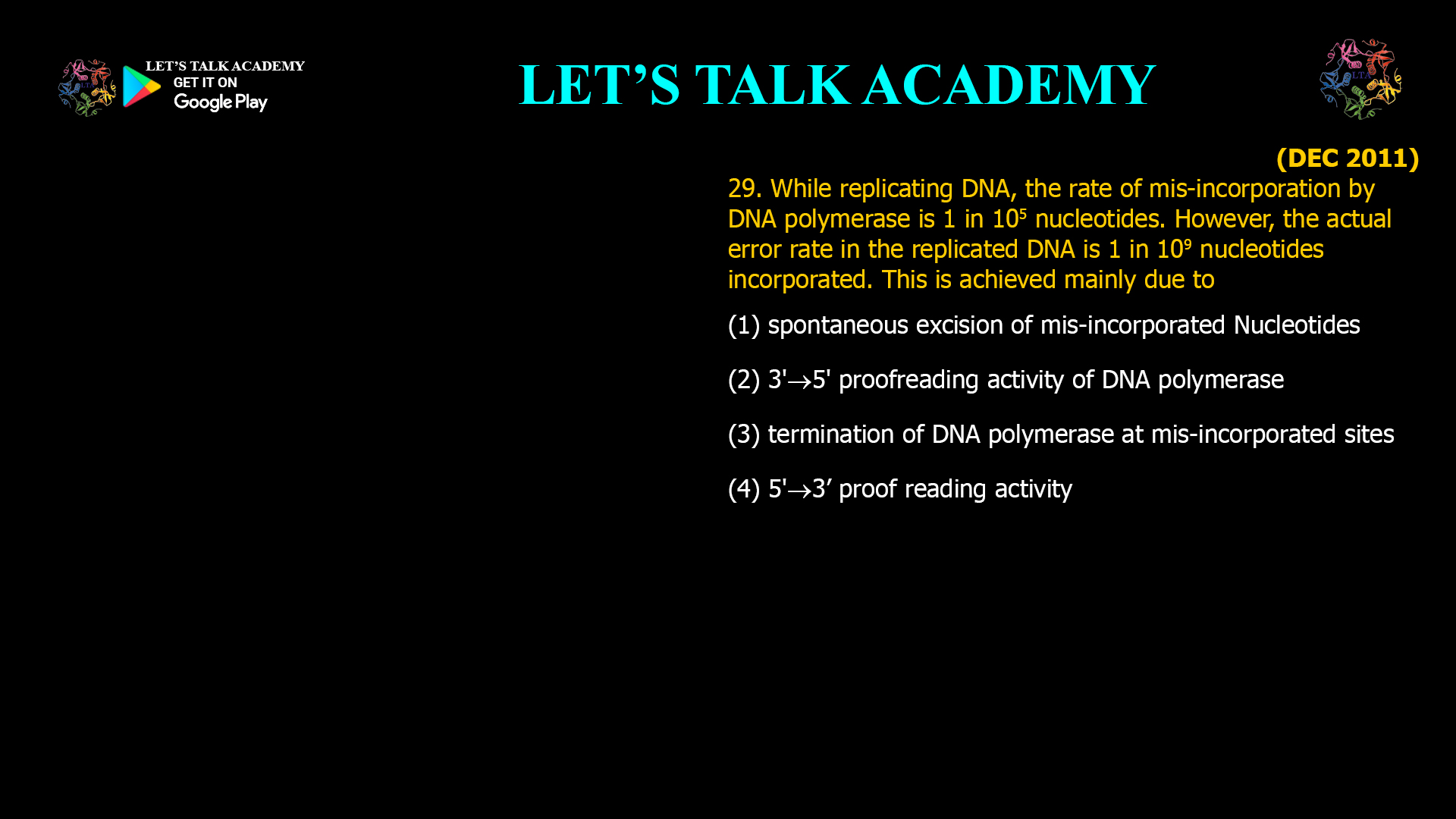- While replicating DNA, the rate of mis-incorporation by DNA polymerase is 1 in 105 nucleotides. However, the actual error rate in the replicated DNA is 1 in 109nucleotides incorporated. This is achieved mainly due
to
(1) spontaneousexcision of mis-incorporated
Nucleotides
(2) 3’à5′ proofreading activity of DNA polymerase
(3) termination of DNA polymerase at mis-incorporated sites
(4) 5’à3’ proof reading activity
Introduction
DNA replication is an essential cellular process that must be highly accurate to maintain genetic integrity. Although DNA polymerases incorporate nucleotides with high specificity, the initial error rate during nucleotide incorporation is approximately 1 in 10^5. However, the actual mutation rate in replicated DNA is much lower, about 1 in 10^9 nucleotides. This dramatic improvement in fidelity is primarily due to the proofreading activity of DNA polymerase.
What Causes the Discrepancy Between Initial and Actual Error Rates?
-
Initial misincorporation rate: DNA polymerase occasionally incorporates incorrect nucleotides during DNA synthesis, roughly 1 error per 100,000 nucleotides.
-
Final error rate: After proofreading and repair, the error rate drops to about 1 error per 1 billion nucleotides, ensuring genome stability.
This difference is mainly attributed to the proofreading function of DNA polymerase, which corrects errors immediately after they occur.
The Proofreading Mechanism: 3′→5′ Exonuclease Activity
-
DNA polymerases possess a 3′→5′ exonuclease activity, which scans the newly added nucleotide at the 3′ end of the growing DNA strand.
-
If a mispaired or incorrect nucleotide is detected, the polymerase pauses and transfers the DNA strand from the polymerase active site to the exonuclease active site.
-
The exonuclease excises the incorrect nucleotide by cleaving the phosphodiester bond, removing the mismatch.
-
The corrected primer terminus is then repositioned back to the polymerase site for continued DNA synthesis.
This proofreading step significantly reduces the incorporation of errors into the genome.
Why Other Options Are Not Responsible for the High Fidelity
-
Spontaneous excision of mis-incorporated nucleotides:
-
This is not a major contributor. DNA polymerase actively removes errors rather than relying on spontaneous removal.
-
-
Termination of DNA polymerase at mis-incorporated sites:
-
DNA polymerase does not terminate synthesis upon errors; instead, it corrects them via exonuclease activity.
-
-
5′→3′ proofreading activity:
-
DNA polymerases do not have 5′→3′ proofreading exonuclease activity. The 5′→3′ exonuclease activity is involved in primer removal, not error correction.
-
Summary Table
| Mechanism | Role in Error Correction | Correctness as Main Fidelity Mechanism |
|---|---|---|
| Spontaneous excision | Minimal role | No |
| 3′→5′ exonuclease proofreading | Removes misincorporated nucleotides | Yes |
| Termination at mis-incorporated site | Not a mechanism for fidelity | No |
| 5′→3′ proofreading activity | Does not exist in DNA polymerase | No |
Conclusion
The remarkable accuracy of DNA replication is largely due to the 3′→5′ exonuclease proofreading activity of DNA polymerase. This function allows the enzyme to detect and excise incorrectly incorporated nucleotides immediately, reducing the error rate from 1 in 10^5 to 1 in 10^9 nucleotides. This proofreading mechanism is essential for maintaining the genetic stability of all living organisms.
Correct answer:
(2) 3′→5′ proofreading activity of DNA polymerase




26 Comments
Surbhi Rajawat
July 29, 2025Ans is 2. Because all three polymerasees that is 1 2 and 3 have proof reading activity which decreases the mistakes in replication
anurag giri
July 29, 2025Ans 2 bcoz wrong nt remove by 3’-5’ exo nuclease activity ( proof reading) effectively
Mansukh Kapoor
July 29, 2025The correct answer is option 2nd because the accuracy can be attained by the 3′—-5’exonuclease activity (proof reading activity)
Priti Khandal
July 29, 2025Option 2 is right sir because polymerase ke pass proof reading activity present hoti h
Priya Khandal
July 29, 20252 is right
Juber Khan
July 30, 2025The correct ans is (2) bcz the actual error rate in replicated dna is achieved du to 3′ to 5′ proofreading activity of dna polymerase
Khushi Agarwal
July 30, 2025The correct answer is option 2
Bcs dNA polymerase ki 3′ – 5′ proofreading activity hi major reason hai ki DNA replication mein errors bahut kam hote hain.
shruti sharma
July 30, 2025OPTION 2 ,DNA polymerase has proofreading activity
Payal Gaur
July 30, 2025In error 3′ to 5′ exonuclease use for proof reading activity
Deepika Sheoran
July 30, 2025Option 2nd is correct
Dna polymerase has proof reading activity.
3’_5′ exonuclease activity.
Proof reading activity present in Dna polymerase 1st.
Pratibha Sethiya
July 30, 2025Correct option is option (2)
Aafreen
July 30, 20253′-5′ proof reading activity of DNA polymerase reads newly synthesized DNA if an incorrect nucleotide is added than this activity removes it
Khushi Vaishnav
July 31, 20253′-5′ proofreading activity of DNA polymerase is correct
Diksha Chhipa
July 31, 2025Replication error rate is decreased by 3 to 5 prime exonuclease activity. Which is proof reading activity. Wrong ntds bind but due to this activity it dissociates
Anisha jakhar
July 31, 2025Option 2.
Soniya Shekhawat
July 31, 2025By proof reading activity (3’to5′ exonuclease)is decrease the replication error so these proof reading activity in prokaryotes are present in DNA polymerase 1,2,3
Santosh Saini
July 31, 2025Pol. 1, 2, and 3rd have 3’to 5’exonuclease activity (proofreading) for removing mismatch nt . So option 2nd is right
Dharmpal Swami
August 1, 20253′ to 5′ exonuclease proofreading remove misincorporated nt
Shivani
August 1, 2025Done sir 👍
Dipti Sharma
August 1, 2025Dna polymerase has proofreading activity.
Khushi Mehra
August 1, 2025Dna polymerase have 3′-5′ exonuclease proofreading activity due to which incorrect base pair replaced by correct base during replication
Avni
August 1, 20253’-5′ proofreading activity of DNA polymerase is the correct answer
Mahima Sharma
August 2, 20253 to 5 proofreading activity o dna polymerase
Varsha tatla
August 3, 2025Option 2 is absolutely correct one
Deepika Sheoran
November 6, 2025DNA polymerase has proof reading activity 3′-5′ Exonuclease Activity. Proof reading activity present in DNA polymerase 1st.
Komal Sharma
November 15, 2025The remarkable accuracy of DNA replication is largely due to the 3′→5′ exonuclease proofreading activity of DNA polymerase.